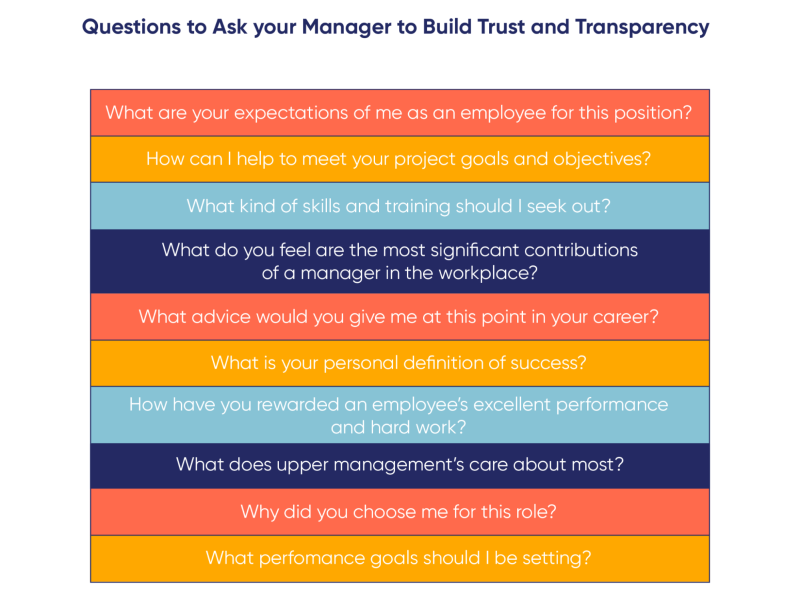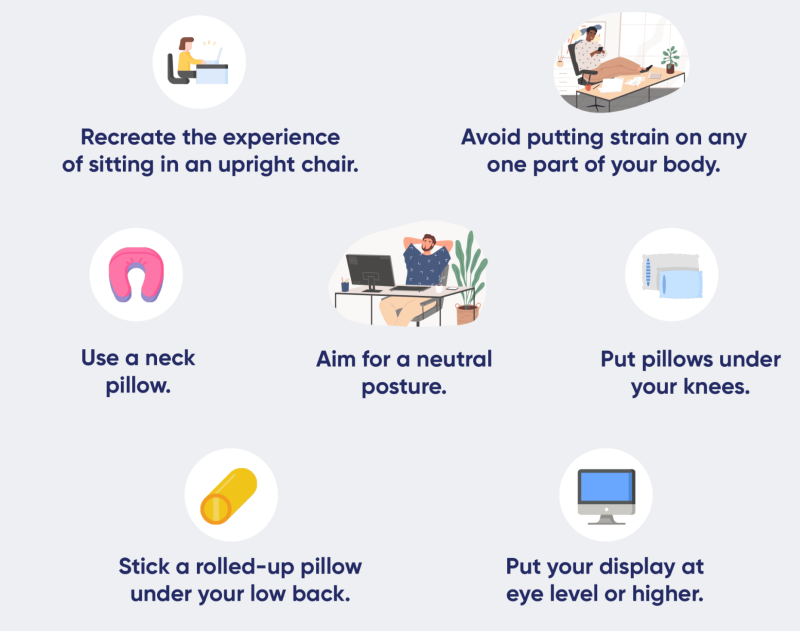

If you’re wondering how to work remotely, you are not alone. Whether you’ve been working from home for years or were forced into remote work during the coronavirus pandemic, remote work does come with some challenges.
Maintaining a healthy work-life balance, connecting with your colleagues, and staying focused are a few examples of the difficulties remote workers face. But, by following some simple tips and guidelines, you can make the most of your new (or not-so-new) situation.
In this article, we’ll share 26 work from home tips for success, so you can design the work from home experience you’ve been yearning for.
Communication tips for working from home
1. Build trust with your managers
Although we have more technology to aid in project management, communication, and time-tracking, trust between managers and employees is decreasing — and remote work is adding to the strain.
Managers are afraid to give employees feedback, from wanting to avoid potential conflict to fearing that a conversation may upset or disrupt an employee. But employees are actually craving more feedback.
The key to navigating this challenge? Putting your manager at ease about your intentions by knowing how to ask the right questions.

2. Over-communicate
Erring on the side of over-communicating is essential when working from home full-time or even part-time. Be sure to ask for clarification around assignments, details, meetings, and anything else you’re unsure of.
If you’re using a text communication platform like Slack and you’re still unclear about something, try video conferencing or jumping on a Zoom call. Your team will appreciate your willingness to understand and your attention to detail.
3. Nurture relationships with colleagues
Following the same rituals you would in an onsite workplace is just as important when working from home.
Nurturing and maintaining relationships with your colleagues is a big part of that. This means being a part of online group conversations and one-on-one conversations — both formally and informally, when appropriate.
For instance, if there’s a ‘water cooler’ channel on your messaging platform, join the lighthearted fun with a meme or fun fact. The same goes for one-on-one conversations. Even a simple ‘how’s your day going?’ is enough to make you feel connected.
Conversations can feel different when you can see the other person’s face. So, try to schedule some time aside for virtual face-to-face catch-ups. You’ll get to know your co-workers on a different level than through messaging apps alone.
While your primary focus will be on tasks, having positive relationships at work will help you prevent loneliness and social isolation at work.
4. Be responsive
When you’re part of a remote team, that team relies on online communication tools to relay important messages. Responding to messages or adding a thumbs-up or a checkmark emoji will show the team that you’re paying attention.
To help you remember important messages, save them in a place you can easily reference.
5. Build effective communication habits
When communicating with your team, be thoughtful, considerate, and solution-focused. Being transparent and communicating effectively is one of the best ways to prevent and solve problems efficiently.
6. Assume positive intent
Keep in mind that when you’re communicating via chatting platforms, it can be difficult to express ideas clearly and convey tone. This means that quick remarks might come off as flippant or rude.
But instead of taking short remarks offensively, assume positive intent. Some team members are always busy when replying, and others prefer to be efficient in their replies.
Another tip: Consider using emojis to convey tone when communicating with your team.
Working from home tips to set healthy boundaries
7. Define your workspace
It’s beneficial to have a designated workspace that’s not in one of your living areas, such as your bedroom or living room.
Susan Hallbeck, director of healthcare-system engineering at the Mayo Clinic, says that your back, hips, and neck are more strained when you’re on a soft surface like a couch or a bed.
From headaches to arthritis to neck pain, if you’re on a soft surface, “you’re really not supported in a way that’s conducive to work,” Susan says. What’s recommended is having a comfortable chair with proper back support and keeping your screen at eye level.

However, if you do continue working in bed, here are some ways to support your body:
- Recreate the experience of sitting in an upright chair
- Avoid putting strain on any one part of your body
- Use a neck pillow
- Aim for a neutral posture
- Stick a rolled-up pillow under your low back
- Put your display at eye level or higher
- Put cushions under your knees
- Don’t lie on your stomach.
Note: If it’s at all possible, invest in an ergonomic workstation and get up to stretch your body every 45 minutes.
8. Create a morning routine
Often, remote employees wake up, grab a cup of coffee and a snack, then go straight to opening their laptops to work. But from that point on, the whole day can feel like rushing from one thing to the next.
Instead of being in a go-go-go state as soon as you wake up, consider creating a morning routine to set the tone for a healthy and productive day.
For instance, create a short routine, like drinking green juice, doing five minutes of tai-chi, and reading a chapter in your current book. Or, try a long routine, like eating breakfast and following it up with an hour’s walk (no technology allowed).
9. Try setting a work schedule
Our business and work environment is becoming increasingly more demanding and less predictable. Before the Covid-19 pandemic, only 17% of U.S. employees worked from home, which increased to 44% during the pandemic.
But remote working is unlikely to disappear entirely, even post-pandemic. As our work environment continues to be fast-changing, we need to focus on structure and accountability to see us through.
That’s why having a work schedule with specific working hours is essential even while you’re working at home.

Additionally, having a set schedule can help you:
- Keep yourself accountable
- Finish deadlines early or on time
- Post office hours so clients, co-workers, and managers can get a hold of you
- Increase your productivity
- Make the most out of your workday
- Have a healthy work-life balance
- Build resilience through routines
- Prevent burnout
But having a set schedule doesn’t mean you have to work the typical 9-5 if that’s not for you. Our bodies are more energetic and motivated at specific times of the day. The key is to create a schedule that supports your body’s natural ebbs and flows.
For instance, you might have higher energy in the afternoons, and working from 11 a.m. to 7 p.m. is better for you. Or, you might be an early bird and prefer to work from 6 a.m. to 2 p.m.
Since we all experience energy differently, we have to find what works best for us rather than for someone else.
10. Create a daily routine
A daily routine is just as important as your morning routine. As we touched on before, find what works for you by trying a few different schedules.
Maybe that means working in the early morning, afternoon, or evening. Or perhaps that means working four days a week and relaxing or adventuring three days a week. Aim to have a plan for your mornings, afternoons, and evenings.
For instance, follow your morning routine early, follow your work schedule in the afternoon, and catch up with loved ones in the evenings.
11. Limit distractions
Fewer distractions at work means more productivity. When you’re in work mode, it’s important to set boundaries with loved ones and kids who may be at home with you.
For instance, tell your loved ones that you won’t be available during working hours and ask them not to open your door unless it’s an emergency.
The same goes for social media and notifications. Sign out of personal emails and social media channels on your desktop and turn on ‘do not disturb mode on your phone to avoid hearing notifications during work hours.
You can also try a digital detox if you want to take a total break from social media.
Drawing boundaries around your work is essential to preventing work from bleeding into your personal life and vice versa. It will help you log off at the end of the day knowing that you accomplished what you could during working hours.

12. Know when to stop working
Whether it’s finishing a project or prepping for the next day, it’s easy to find reasons to keep working past your scheduled work time. Doing this when absolutely necessary is okay, but making a habit of overworking can lead to burnout, emotional exhaustion, and even depression.
A study of 20,000+ adults in the BMJ’s Journal of Epidemiology & Community Health found that after income, age, job characteristics, and health, women who worked extra-long hours had 7.3% more depressive symptoms than women working a standard 35-40 week.
Additionally, working on the weekend was linked to a higher risk of depression among both men and women.
If you find yourself still working past your scheduled work time, pay attention to the cues your mind and body send you. Are you dozing off? Do your eyes hurt? Do you have low energy?
If your mind and body are signaling that they’re running out of battery, it’s time to put work away until tomorrow.
Working from home self-care tips
13. Take regular breaks
Working from home generally results in less walking and moving around, which can negatively affect your long-term health.
To prevent this, try setting scheduled alarms every 45 minutes to remind you to get up, stretch, and walk around for a few minutes. If possible, move away from your workstation during breaks to help you refresh before returning to work.
Alternatively, you can try the Pomodoro Technique. In short, this method structures a five-minute break every 25 minutes. It’s been touted with such benefits as reducing mental exhaustion and improving concentration.
Even a five or 10-minute break can be refreshing, so try not to steamroll through the day without pausing.
14. Take care of your physical health
Physical activity impacts conditions like depression, anxiety, cognitive agility, and stress tolerance. Without physical well-being, you can’t have mental well-being.
For optimal physical health, it’s essential to have proper hygiene, a healthy diet (don’t skip your lunch break), plenty of water, adequate sleep, and regular exercise. Set realistic goals and focus on your strengths instead of your weaknesses.
For instance, if you loathe running, don’t force yourself to run. Instead, focus on the physical activity you enjoy — i.e., swimming, walking, and cycling are great alternatives. If possible, add physical activity to your morning routine and make sure to take walking breaks during the day.
15. Improve your mental fitness
Just like exercise programs improve health and well-being, employees need the practice to strengthen their psychological core. Building resilience, coping skills, and understanding how to manage stress are buffers against depression and panic.
Keep in mind that these healthy habits look different for different people. For instance, some employees may prefer regular meditation and yoga to cope with stress, while others may prefer deep breathing and meeting with mental health and well-being coaches.
Focus on building your own coping skills toolkit. For you, that may be taking your mind off a problem with a puzzle, nurturing your emotional intelligence, or writing down positive affirmations. If you find yourself still struggling, don’t be afraid to ask for support.
16. Set up an ergonomic workstation
We mentioned this a bit earlier, but it doesn’t hurt to say it again. Be sure to set up an office that supports your physical health.
Consider alternating between a standing desk, a yoga ball, and a seated desk. Or, invest in a comfortable chair with back support, a footstool, and a computer stand to keep your screen at eye level.
17. Go easy on yourself
If this is your first time working from home, go easy on yourself. It’s normal to feel frustrated, confused, or unmotivated. And on the flip side, it’s normal to feel excited and relieved. Give yourself some grace and practice self-compassion as you transition into your new work-from-home life.
18. Have a life outside of work
To support your overall well-being, it’s essential to have meaningful relationships and activities outside of work.
In studying professionals for two decades, Rob Cross, the Edward A. Madden Professor of Global Leadership at Babson College and co-founder and research director of the Connected Commons, has found a predictable pattern behind why some working professionals go off track:
When professionals become hyper-focused on work and believe it will provide the money, status, and meaning they’re looking for, it often goes wrong. They end up unhealthy, possibly divorced, and with limited friends and activities to help them get out of their situation.
The same studies show that people who manage to succeed at work while reporting stronger well-being overall are maintaining social connections and outside activities in spiritual, civic, personal, and family pursuits.
This means that having a life outside of work is essential to creating meaning and overall well-being in your life.
19. Get some fresh air
When you’re used to being home all day, it can be difficult to leave the house — especially when nearly anything you need can be delivered to you. But stepping outside for some fresh air can be regenerative for your physical and emotional health.
Dr. Eric Morley, a pediatrician at MemorialCare Saddleback Medical Center in Laguna Hills, California, says, “while there is no magical ‘fresh-air cure,’ there are clearly both physical and emotional health benefits to spending more time outside in the fresh air.”
Whether it’s eating lunch outside, going for a short walk, or just standing outside for a few minutes, make sure to get some fresh air as often as you can.
20. Engage with your community
Social dynamics shift when working from home. Our work colleagues are only accessible through technology and even if loved ones are home, we can still feel disconnected and isolated from the outside world.
Being a part of your local community can help navigate this challenge. This can mean volunteering at your neighborhood vegetable co-op, participating in HOA events, or having meaningful conversations with your neighbors.

Processes for working remotely
21. Streamline repetitive processes
One of the best ways to make the most of your time at work is to streamline repetitive processes.
For instance, let’s say you’re a content writer for businesses. Instead of starting your outlines from scratch every time, create outline templates for each client.
Or, if you’re a social media marketer, create a digital vault of caption templates. Do this for every system you have at work — from client management to project management and everything in between.
22. Look for shortcuts
Piggybacking on the previous tip, stretch your time by finding shortcuts.
For instance, if you’re a researcher looking for a specific finding in a study, use ctrl+f on your keyboard to find the text you’re looking for quickly, instead of scrolling through the entire study (command+F if you’re using a Mac).
Or, if you’re an operations manager, use digital automation to reduce manual tasks.
23. Plan and organize your tasks
Reduce stress and overwhelm by breaking down big-picture items into digestible pieces. To plan and organize your tasks, consider using a digital platform with a Kanban system, like Trello.
Not only will this save you time on managing tasks, but it will also help you focus on one task at a time.
24. Adjust and improve as needed
As your career progresses, you’ll likely run into a variety of changes within your role, along with added responsibilities. To ensure that your processes are always working for you, analyze, adjust, and improve your processes as needed.
For instance, maybe you originally created automations with a workflow management platform, but after trial and error, you realized a productivity platform was a better fit for your needs.
Since no processes are perfect, continuously improving and adjusting your processes will eliminate unnecessary tasks and improve productivity and efficiency.
25. Invest in quality technology
When you’re managing communication, research, and assignments, you need reliable, high-speed technology to support your work needs. To find equipment that supports your needs, start by making a list of top priorities.
For instance, does your system need to be portable? Do you need long battery life? A detachable display? A lot of storage?
After you’ve made your list, do some research to find out what other criteria you need to add to your list. Once you’re clear on what to look for you’ll be able to make an informed decision about which system to invest in.
Work from home tips to save money
26. Reduce your utility consumption
When we’re working onsite, we usually don’t think about how much water we use, the lights we turn on, or how much heat and air conditioning we’re consuming.
But, when we’re working from home, we have to prepare for an increase of up to 15 to 20% or more, depending on how much we use.
To reduce your utility consumption, try this:
- Ask your utility companies for consumption reduction tips.
- Unplug devices that aren’t in use.
- Use natural light as often as possible.
- Turn off lights in rooms that aren’t in use.
- Take shorter showers.
- Turn off the water when you’re brushing your teeth.
- Limit how often you use large power appliances (i.e., dishwashers and dryers).
- If possible, turn off heat and A/C in rooms that aren’t in use.
- Ask your job if they offer work from home credits
More and more employers are acknowledging the added expenses their employees are accruing from working from home, especially after the pandemic.
As a result, some companies have decided to pay for some of their remote employees’ expenses such as desks, chairs, computers, WiFi, phone costs, and utility bills. For instance, E-commerce company Shopify announced that it would give its remote employees $1,000 for a new home office.
With that in mind, it never hurts to ask your employer if they offer utility rebates, WiFi allowance, or bonuses for working from home. Even if they don’t currently offer credit, if enough employees ask about it, they may consider offering it in the future.
Find what works for you
Remote workers report equal productivity to onsite workers. They also feel a greater sense of creativity and energy at home than in the office. Remote workers are even slightly more satisfied with their work than those who work fully onsite.
The key? Designing routines that work for them.
The best way to work from home is by finding what works for you. It’s okay if you’re still trying to design the most helpful schedule and boundaries.
With a little patience, enthusiasm, and some trial and error, you’ll design a system that works best for you.
To your success
We hope these working from home tips were just what you needed to read today. If you’re interested in learning more about how to work from home, we’d be happy to help you sharpen your skills.









You must be logged in to post a comment Login